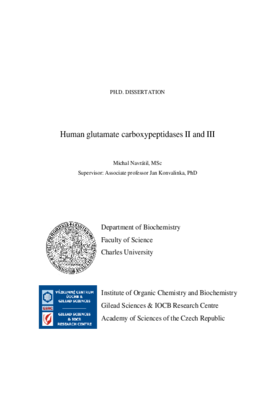Human glutamate carboxypeptidases II and III
Lidské glutamátkarboxypeptidasy II a III
dizertační práce (OBHÁJENO)

Zobrazit/
Trvalý odkaz
http://hdl.handle.net/20.500.11956/83880Identifikátory
SIS: 90060
Kolekce
- Kvalifikační práce [20352]
Autor
Vedoucí práce
Oponent práce
Obšil, Tomáš
Pavlíček, Jiří
Fakulta / součást
Přírodovědecká fakulta
Obor
-
Katedra / ústav / klinika
Katedra biochemie
Datum obhajoby
20. 6. 2016
Nakladatel
Univerzita Karlova, Přírodovědecká fakultaJazyk
Angličtina
Známka
Prospěl/a
Klíčová slova (česky)
GCPII, GCPIII, vztah mezi strukturou a aktivitou, testování aktivity, určování struktury pomocí rentgenové difrakceKlíčová slova (anglicky)
GCPII, GCPIII, structure - activity relationship, activity assay, X-ray structure determinationZde presentovaná doktorská disertační práce popisuje kinetickou a strukturní characterisaci lidských glutamátkarboxypeptidas II a III (GCPII a GCPIII) za použití jejich přirozených substrátů. Tyto enzymy odštěpují C-koncový glutamát z jejich substrátů. Proteiny sdílejí 67 % sekvenční identitu a také podobné enzymové aktivity. Tato disertační práce kvantitativně porovnává lidskou GCPII a GCPIII co se týče jejich schopnosti hydrolysovat endogenní substráty N-acetyl-L-aspartyl-L-glutamát (NAAG), folyl-poly-γ-L- glutamové kyseliny (FolGlun) a β-citryl-L-glutamát (BCG). Prokázali jsme, že hydrolysa těchto substrátů pomocí GCPIII je závislá na přítomnosti kationtů kovů, že BCG je specifický substrát GCPIII, a že NAAG a FolGlun jsou specifické substráty GCPII. Rovněž přinášíme nepřímé biochemické důkazy o tom, že GCPIII by mohla mít v aktivním místě heterometalický klastr. Také jsme charakterisovali relevanci povrchového vazebného místa v GCPII, takzvaného aromatické skupiny vázajícího místa (ASVM), pro hydrolysu FolGlun substrátů za použití metody cílené mutagenese basí DNA a enzymové kinetiky a ukázali jsme, že polymorfní varianta GCPII His475Tyr hydrolysuje substráty FolGlun se stejnými kinetickými parametry jako divoký typ. Dále se tato disertační práce se zaměřuje na strukturní aspekty substrátových...
The herein presented Ph.D. dissertation describes kinetic and structural characterization of human glutamate carboxypeptidases II and III (GCPII and GCPIII) using a complete panel of their natural substrates. These enzymes hydrolyze C-terminal glutamate from their substrates. They share 67 % sequence identity and also similar enzymatic activities. This thesis quantitatively compares human GCPII and GCPIII in terms of their ability to hydrolyze the substrates N-acetyl-L-aspartyl-L-glutamate (NAAG), folyl-poly-γ-L-glutamic acids (FolGlun) and β-citryl-L-glutamate (BCG). We demonstrated that GCPIII hydrolyzes its substrates in a metal- dependent manner, that BCG is a specific substrate of GCPIII, and that NAAG and FolGlun are specific substrates of GCPII. We also provide indirect biochemical evidence that GCPIII might feature a heterometallic active-site cluster. Additionally, we characterized the relevance of a surface exosite of GCPII, the arene-binding site (ABS), for the hydrolysis of FolGlun substrates using mutagenesis and enzyme kinetics and showed that polymorphic His475Tyr variant of GCPII hydrolyzes FolGlun substrates with the same kinetic parameters as the wild-type enzyme. Furthermore, this thesis focuses on structural aspects of the substrate specificities of GCPII and GCPIII: we present...
